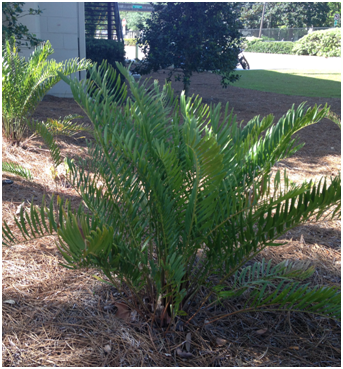Zamia
Zamia pumila

(Photo by Phillip Lowe)
View the Location on Campus
Taxonomy (1,2,3)
Classification: Gymnosperm
Family: Zamiaceae
Common name: Zamia, Coontie Palm, Coontie
General Information (1,3,4)
Region of Origin: Florida
USDA Plants Hardiness Zones: 8b-11
Growth Habit: Shrub
- Size: 3-5 feet
- Deciduous/Evergreen: Evergreen
- Coning: Late winter
Diagnostic Characteristics
Leaves (2)
- Simple/Compound: Compound
- Other: 60-120cm; revolute; petioles prickly
Pollen Cone (2)
- Color: Rusty brown
- Size: 3-15cm
- Shape: Cylindrical
Seed Cone (2)
- Size: 6-15cm
- Shade: Elongate-ovoid
- Color: Reddish
Horticultural Information (1,2,3,4)
- Light: Full sun to partial shade
- Soil type: Sand, sandy loam
- Maintenance: Easy to care for
- Landscape Uses: Groundcover, shady gardens, transition plant, containers
- Other: Salt tolerant, drought tolerant
Interesting Facts (1,4)
- Poisonous when eaten raw
- Used in bonsai
- Starch from this plant was used for bread
References
1) Coontie palm. (2009). Retrieved from http://www.botanical-journeys-plant-guides.com/coontie.html
2) Zamia pumila. (n.d.). Retrieved from http://en.wikipedia.org/wiki/Zamia_pumila
3) Zamia pumila. (n.d.). Retrieved from http://davesgarden.com/guides/pf/go/162189/
4) Scheper, J. (1997, January 01). Zamia pumila. Retrieved from http://www.floridata.com/ref/z/zam_flor.cfm
Prepared by Phillip Lowe as a course requirement for BIOL 3630/5630, Spring 2013
Edited by Jessica Bartek
Edited by Jessica Bartek
Department of Biology
-
Room 2035, 2nd Floor
Bailey Science Building -
Mailing Address
1500 N. Patterson St.
Valdosta, GA 31698 - Phone: 229.333.5759
- Fax: 229.245.6585
Monday - Thursday
8:00AM until 5:30PM
Friday
8:00AM until 3:00PM
Saturday - Sunday
Office Closed